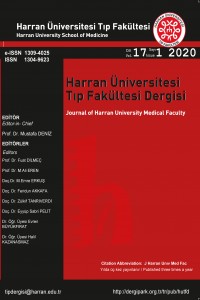Can Lumbar Pedicle Thickness Be a Morphological Parameter in Predicting Lumbar Spinal Canal Stenosis?
Abstract
Background: Lumbar spinal canal stenosis (LSCS) is an important cause of morbidity in the elderly population. Many morphological abnormalities such as facet joint hypertrophy, ligamentum flavum hypertrophy, disc herniation combined with osteophytes associated with LSCS were investigated. Degenerative changes in all the elements of the vertebral bone such as lumbar pedicle thickness (LPT) has not evaluated clearly. The aim of this study to investigate whether LPT can be a morphological parameter to predict LSCS using magnetic resonance imaging (MRI).
Materials and Methods: 150 patients diagnosed clinical LSCS and 150 control subjects who did not have LCSC-related symptoms referred to radiology unit to undergo lomber MRI enrolled the study. LPT was measured at the most stenotic level of the L5 vertebra using axial T2-weighted images.
Results: The mean LPT value was 14.70±1.94 mm in the LSCS group and 14.23±2.00 mm in the control group and was higher in patient group than the controls but did not reach statistical significance (p=0.082).
Conclusion: LPT can not be an effective factor to predict patients with LSCS.
Keywords
Lumbar spinal canal stenosis lumbar pedicle lumbar pedicle thickness Magnetic resonance imaging
References
- Referans 1. An SJ, Seo MS, Choi SI, Lim TH, Shin SJ, Kang KN, et all: Facet joint hypertrophy is a misnomer: A retrospective study. Medicine 2018; 97:24(e11090). Referans 2. Makino T, Kaito T, Fujiwara H, Yonenobu K. Analysis of lumbar pedicle morphology in degenerative spines using multiplanar reconstruction computed tomography: what can be the reliable index for optimal pedicle screw diameter? Eur Spine J. 2012; 21(8):1516–1521.
Lomber Pedikül Kalınlığı Lomber Spinal Kanal Darlığını Öngörmede Morfolojik Bir Parametre Olabilir mi?
Abstract
Amaç: Lomber spinal kanal stenozu (LSKS) yaşlı popülasyonda önemli bir morbidite nedenidir. LSKS ile ilişkili faset eklem hipertrofisi, ligamentum flavum hipertrofisi, disk herniasyonuyla birlikte osteofitler gibi birçok morfolojik anormallik araştırılmıştır. Lomber pedikül kalınlığı (LPK) gibi vertebral kemiğin tüm elemanlarındaki dejeneratif değişikler net olarak değerlendirilmemiştir. Bu çalışmanın amacı LPK’ nın LSKS ön görüsünde morfolojik bir parametre olup olamayacağını manyetik rezonans görüntüleme (MRG) ile araştırmaktır.
Materyal ve Metod: Lomber MRG için radyoloji ünitesine yönlendirilen klinik LSKS tanısı alan 150 hasta ve LSKS ile ilgili semptomları olmayan 150 kontrol grubu çalışmaya dahil edildi. LPK aksiyal T2 ağırlıklı görüntülerde en dar seviye olan L5 vertebra düzeyinde ölçüldü.
Bulgular: LSKS li grupta ortalama LPK değerleri 14.70±1.94 mm ve kontrol grubunda 14.23±2.00 mm idi ve hasta grupta kontrol grubuna göre yüksekti ancak istatistiksel öneme ulaşmadı (p=0.082).
Sonuç: LPK, LSCS’ li hastaları öngörmede etkili bir faktör olamaz.
References
- Referans 1. An SJ, Seo MS, Choi SI, Lim TH, Shin SJ, Kang KN, et all: Facet joint hypertrophy is a misnomer: A retrospective study. Medicine 2018; 97:24(e11090). Referans 2. Makino T, Kaito T, Fujiwara H, Yonenobu K. Analysis of lumbar pedicle morphology in degenerative spines using multiplanar reconstruction computed tomography: what can be the reliable index for optimal pedicle screw diameter? Eur Spine J. 2012; 21(8):1516–1521.
Details
| Primary Language | English |
|---|---|
| Subjects | Clinical Sciences |
| Journal Section | Research Article |
| Authors | |
| Publication Date | April 29, 2020 |
| Submission Date | January 27, 2020 |
| Acceptance Date | March 25, 2020 |
| Published in Issue | Year 2020 Volume: 17 Issue: 1 |
Harran Üniversitesi Tıp Fakültesi Dergisi / Journal of Harran University Medical Faculty


